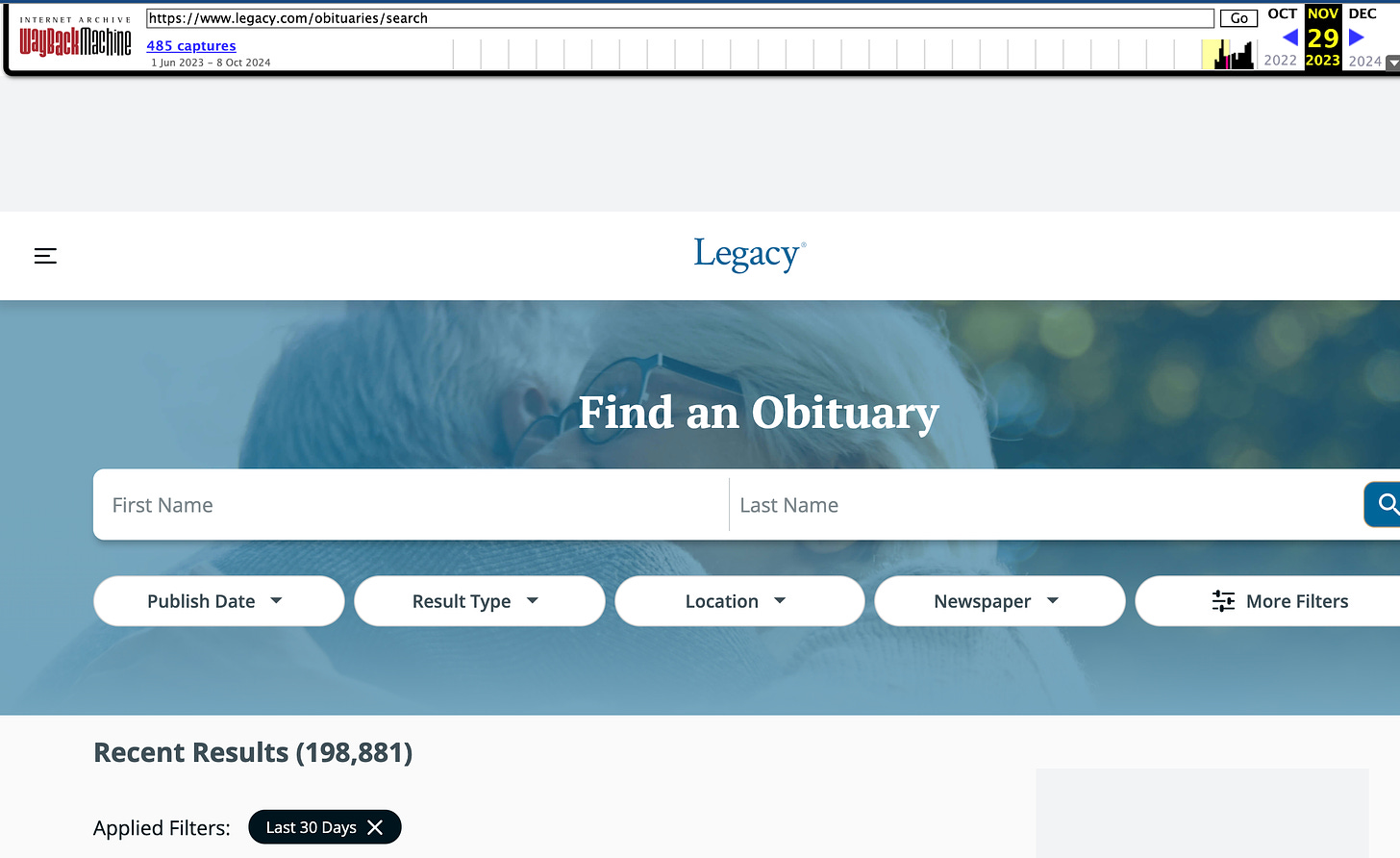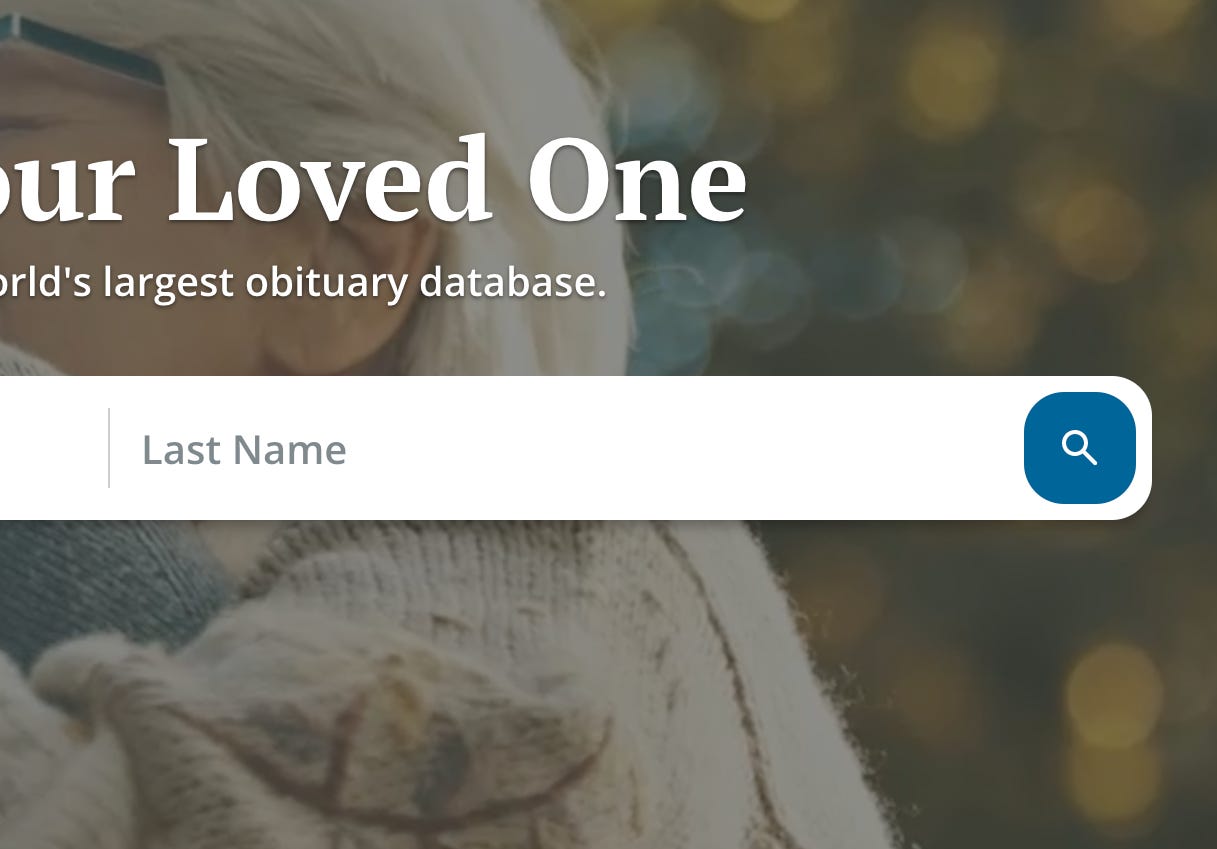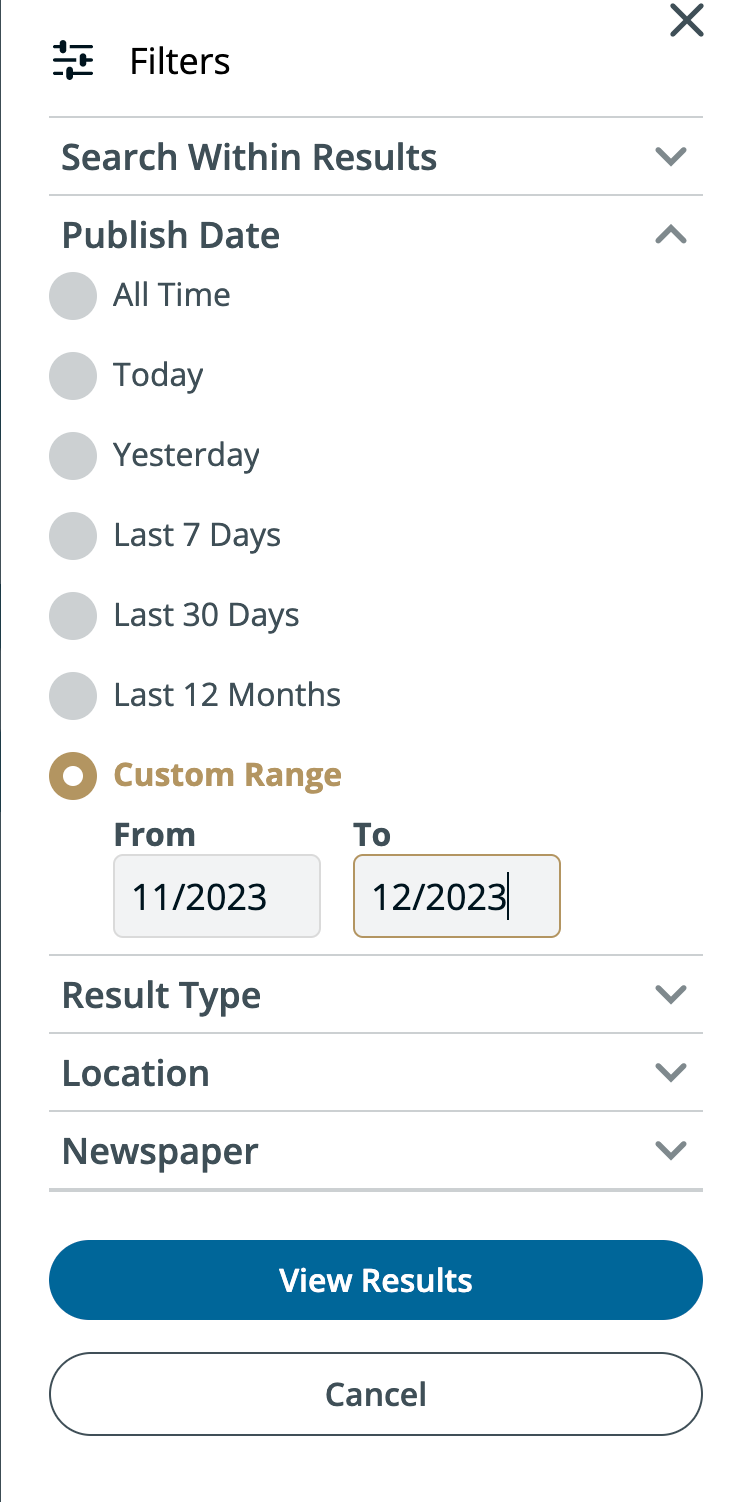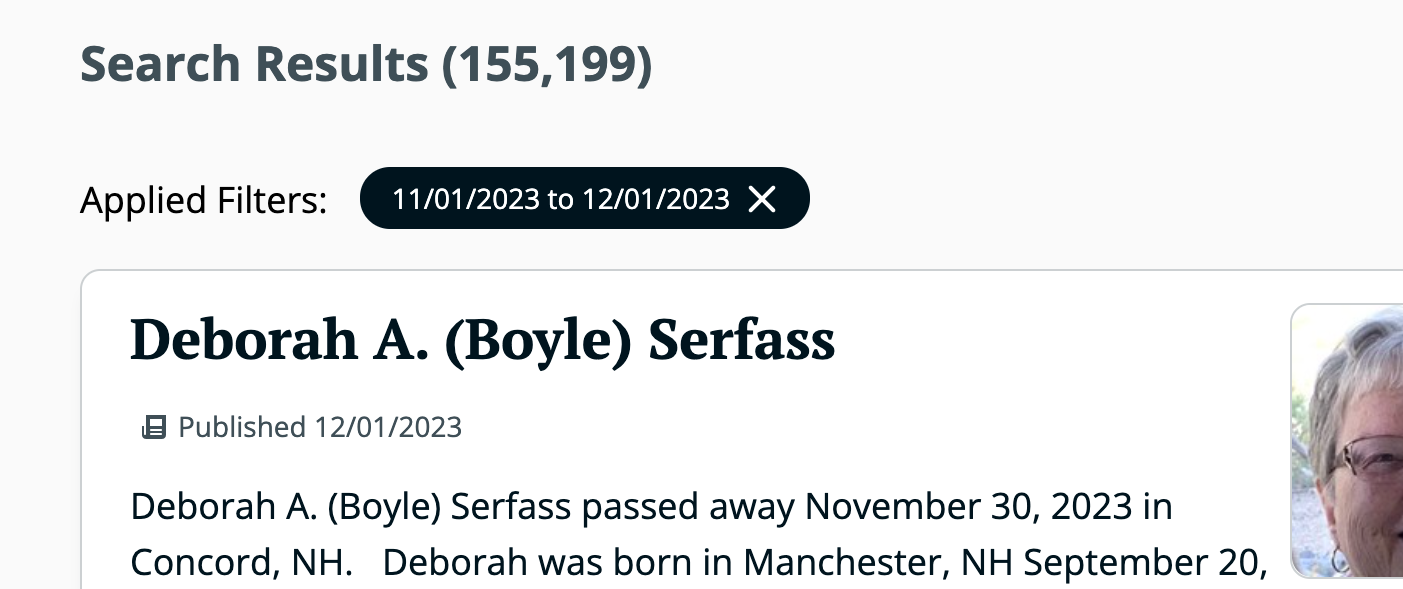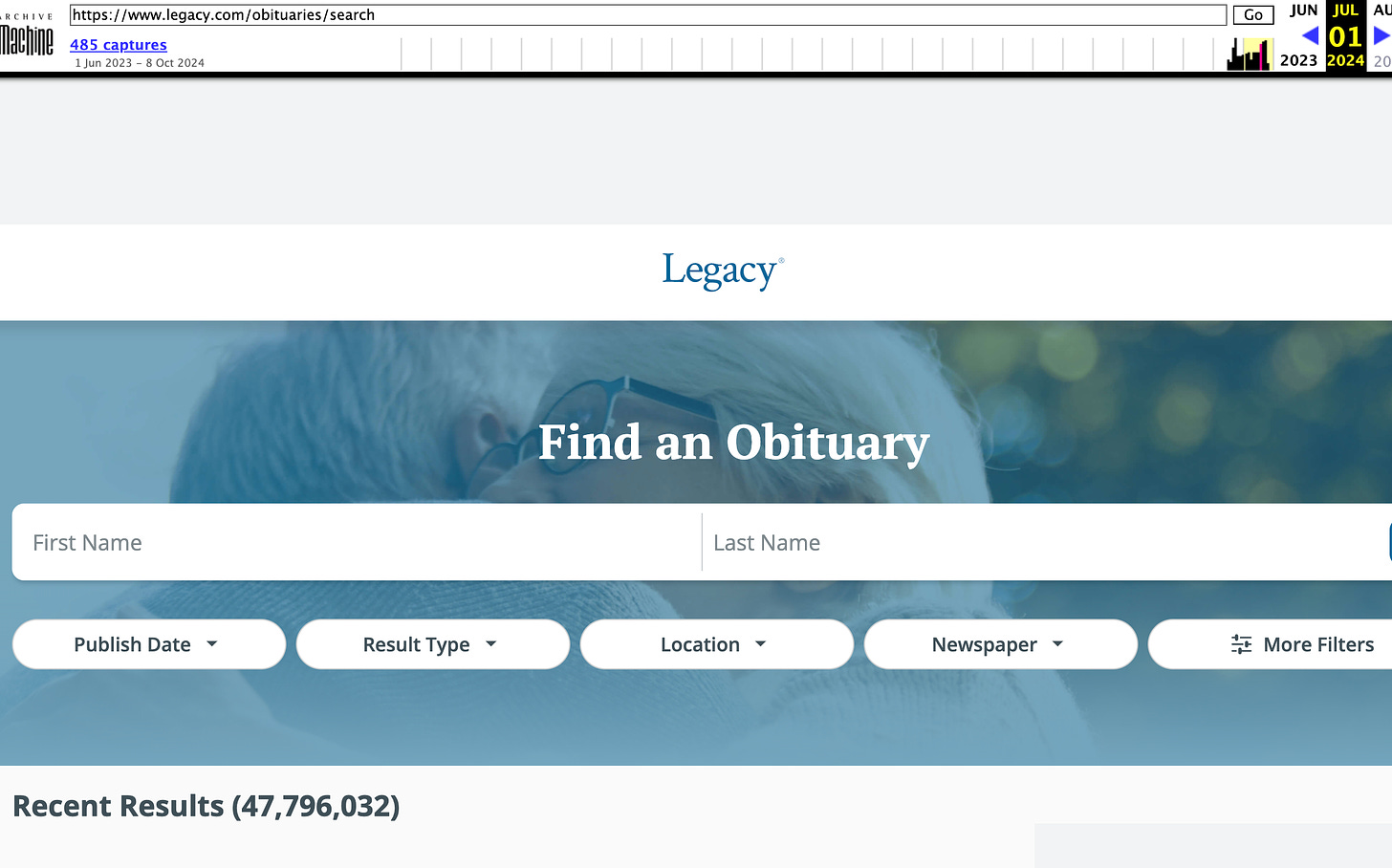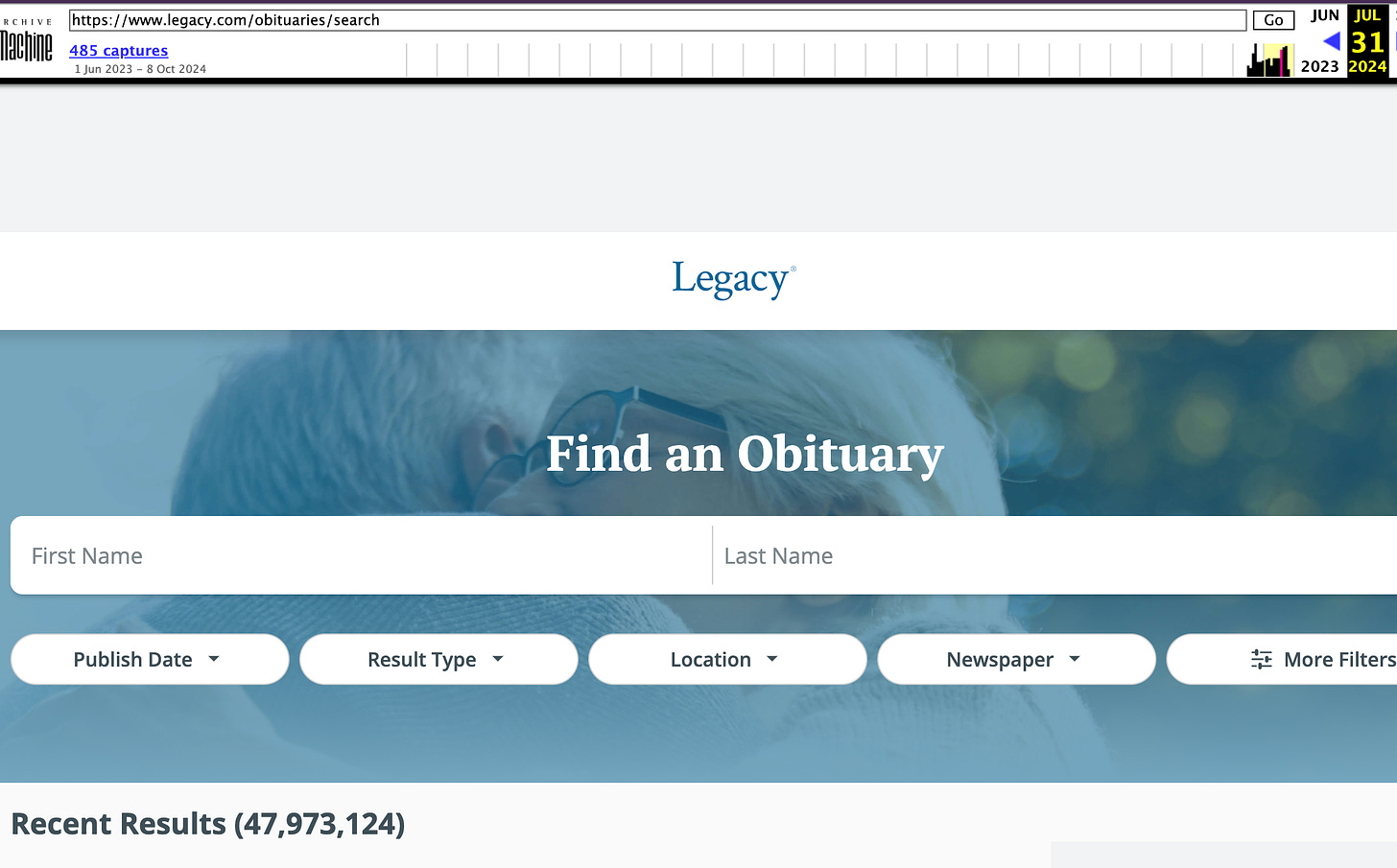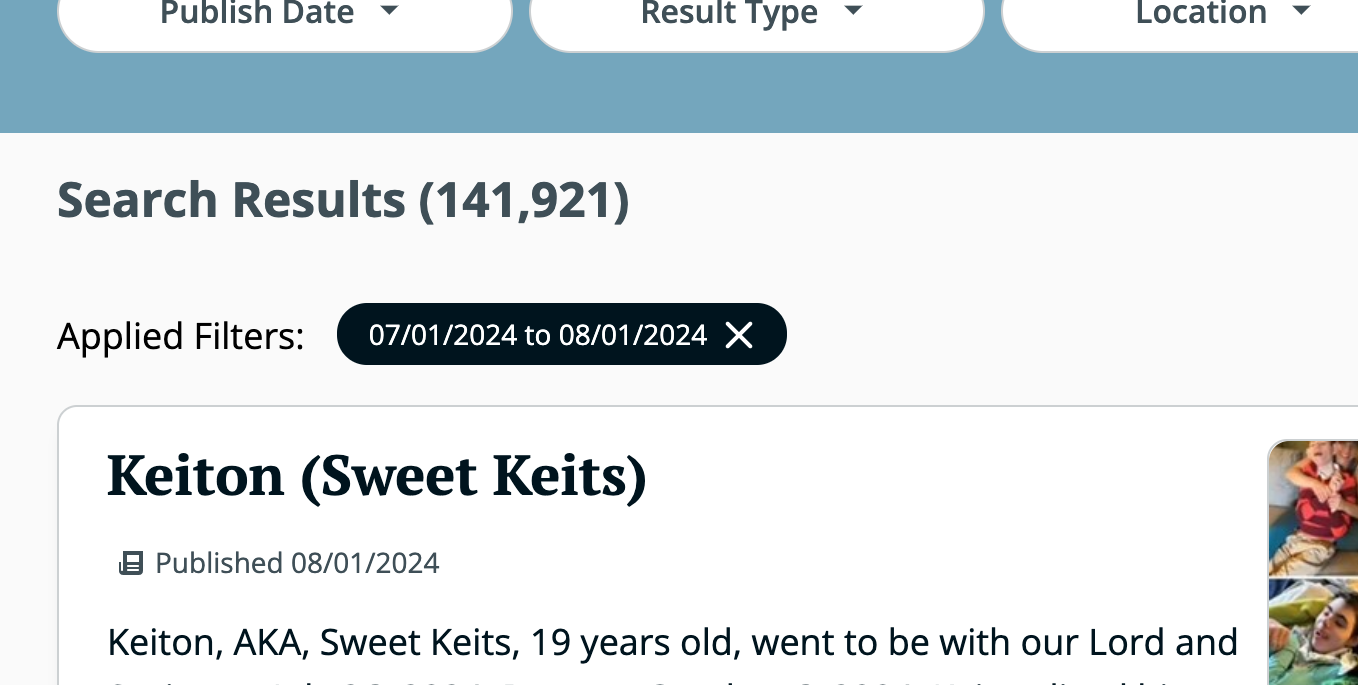*
Bigger than Netflix.
*
So says Legacy.com about itself. Quote:
“Legacy, the #1 destination for online memorial tributes and funeral home information, is a top-50 website in the U.S. with more unique monthly visitors than Wikipedia, Netflix, or LinkedIn. We offer users a permanent, shareable space to commemorate the lives of their loved ones and strengthen their bonds with family and community.
Our 5,000+ funeral home, newspaper, and advertising partners share the SEO dominance of our global-leading network:
40+ million visitors per month
1.2 billion annual website sessions
3.5 million annual obituaries hosted & guest books managed”
*
Legacy goes on to gush about the business opportunities for their partners:
“In late 2022, Legacy quietly embarked on a game-changing initiative to offer every consumer worldwide an easy online way to directly place an obituary in any of our 2,800 partner newspapers. This simple portal has a profound goal: to reinvigorate newspaper obituary volume by smoothing the process between a purchaser and publication.
The results speak for themselves. To date, Legacy’s consumer intake system has delivered $52,000,000 in revenue and 110,000 obituaries to our newspaper partners. Nearly 40% of these orders came in after hours and on-weekends.
Clearly, consumers are embracing this on-demand purchasing model.”
*
*
Am I starting to understand why nobody wants to report the odd bookkeeping I have discovered at the world’s largest obituary database?
Yes, I think I am.
Ever since I became aware of the millions of deaths that have disappeared from Legacy.com’s database, I have been urgently writing every single ‘truth news’ person or outlet that I could think of. Believe me, if you can think of a name in that genre, I have probably sent them a message with links to my evidence. Not a single one has expressed any interest in reporting this story.
Is it because Legacy.com is bigger than Netflix? Too hot to handle? Maybe. Then again, it could be that I have just done a poor job convincing these tellers of truth. In that regard, I don’t know what else to do. I would have hoped that my many posts with instructions on how to reproduce my evidence would have been compelling enough to get their interest. Could be. Or maybe they are all just too busy with their own stories. Probably that is true. Also, they don’t know me from Adam. They must get all kinds of nuts knocking at their door. I will give them the benefit of that doubt.
I can only strive to be as sincere as I am able in writing what I have discovered, and hope that '“somebody” will believe me eventually.
*
… so let’s get back to it.
*
If you're in the death business, selling it as compassion and love, you surely can’t afford to have it cast in any negative light and expect to maintain your rising profits. The downside to being the number one source for the world to share its stories about dead loved ones, is that you may inadvertently be a repository of uncomfortable information … say, if the world had a forced medical procedure enacted upon it and the normal pattern of death changed. Your advertisers (maybe a few of the makers of said medical procedure) may not like that. Keep in mind that Legacy is mainly catering to newspapers and news outlets. And just in case you have never seen this notorious video compilation, now would be a good time to give it a look …
*
Am I starting to understand why somebody might be trying to make things look better than they may be?
Yes I am.
As I reported previously, over two million deaths disappeared overnight from Legacy.com on June 6th of 2024. That would have been approximately 5% of the deaths in its database. Curiously, almost the entirety of that staggering erasure was localized to the post ‘medical intervention’ months and years. I know that because in my first post about Legacy, written back in February of this year, I recorded meticulous statistics, which I have compared to the current data at Legacy.com.
If that wasn’t bad enough, I also recently shared with you my new discovery that Legacy has continued to hack away at their database records. In August of this year alone, an additional 200,000 were removed from that single month’s total obituaries. But they still are not done.
*
Since these major deletions appear to be ongoing, and for some length of time … my past reports, and the numbers they contain, have become non-reproducible using Legacy.com’s search feature. As such, I have had to find another way to show that I am not a liar about these things I am now saying. My main tool in doing that is the Internet Archive and its Wayback Machine. If you have been following my recent posts about what I have been discovering concerning these deletions at Legacy.com, then you are familiar with my instructions on how to use the Wayback Machine.
*
What I have to say at this point, is that it appears Legacy has been deleting tens of thousands of obituaries per month since at least September of 2023 (potentially for longer, but the Wayback Machine data is incomplete). My way of determining this is similar to how I discovered the erasure of those 200,000 deaths in August.
The search you need to perform at the Wayback Machine is the same that I have instructed in all of the earlier posts. Put this URL in the Wayback Machine's search box:
https://www.legacy.com/obituaries/search
That will produce a calendar with 485 results that go back to June of 2023.
For some reason, the dates from June 1, 2023 to September 5, 2023 on that calendar have no actual numbers in the snapshots. Then on September 6, 2023 the snapshots begin to reveal “last 30 day” totals in each image. Why this is … may need to be a discussion for another time. Suffice it to say, that on those post September 6, 2023 days in history, a snapshot was made of the Legacy.com site that recorded its own advertised results. The Wayback calendar will give those 30 day numbers for some time until the following year in February. Then on February 7, 2024 the numbers in the snapshots change to something called “recent results”. This number is a running tally of all obituaries contained in the Legacy.com database since it began in 1998.
So, when calculating the monthly totals archived at the Wayback Machine, I have two methodologies.
With the last 30 day numbers, I try to find a snapshot as close to the beginning or the end of a month as I can (end is best). Let’s use November of 2023 as an example.
The last day of that month available on the calendar is November 29. When we access the snapshot of that day we see this:
Since that is not the last day of the month, we should adjust for the missing day(s). But as it is a month with exactly 30 days, we will stick with the 198,881 … essentially just shifting the 30 day total one day forward. If the month had more or less than 30 days we would find the daily average and add or substract that to compensate.
Now we just need to go to Legacy.com and look at what its database currently says about the same time period.
You will want to use an advanced search. Click on the magnifying glass in the blue square.
*
Then choose ‘more filters’.
*
Then use the ‘publish date’ drop down menu and select a custom range. We only want to see the results for November of 2023.
*
This is what you should see.
*
Now, the last part of our job is to take the first number we found at the Wayback Machine for November of 2023 and subtract this second number we find now at Legacy.com to see if anything has been erased, deleted … lost.
So, 198,881 minus 155,199 equals 43,682.
*
The Wayback Machine has just shown us that somehow over forty thousand deaths were removed from the month of September in 2023.
*
I find that this is happening in all of the months that I look at. Do it yourself please. But here are my results:
September of 2023: deletion of 46,000+
October of 2023: deletion of 30,000+
November of 2023: deletion of 43,000+
December of 2023: deletion of 57,000+
January of 2024: deletion of 48,000+
*
As I say, I have two methodologies to do my calculations. In February of 2024 the numbers switch from the last 30 day figures to the “recent results”. Since this number is the much larger running tally of all obituaries since Legacy started, I approach it this way. I find the earliest day in the month with a “recent results” number and compare that with the latest day in the same month. I subtract the first number from the last to get the total obituaries that have accumulated between the two dates. I then adjust that number for any missing days in that month using the daily average. Let’s do July of 2024.
*
*
Since we have the actual first and last days of the month, all we have to do is subtract the first number from the last. The result of that is 177,092.
*
Now, as before, we go to Legacy.com and see what it now says for the same time period. Do that advanced search again just for July of 2024. This is what you’ll see.
*
When we compare the difference … over 35,000 deaths from July alone are no longer there.
*
Again, a shocker was what I found for August of 2024. I dedicated an entire post to that troubling discovery. Do this method of searching for yourself (as long as the Wayback Machine is up and running). Tell me if you do not see a disappearance of over 200,000 deaths in August 2024.
*
Wait! What am I saying? The REAL SHOCKER was the 2.3 million deaths that went poof in the night between June 6 and June 7 of this year. Please do that search for yourself at the Wayback Machine too.
I’ve shown you how.
*
I plan on a supplemental post to this one providing all the data with screenshots. My total calculations so far for the Wayback Machine data (September 2023 through September 2024) add up to almost 3 million deaths removed in that one year span.
*
postscript
Even though it may seem that way, I really have no agenda against Legacy.com. As I said earlier, they just happen to be in a business that preserves certain things … things that could become inconvenient over time. I honestly believe that Legacy performs a noble service by letting us honor our dead. And I am sure many good and decent people work there.
In the last four years we all have been caught up in something bigger than we could ever have imagined.
*
I did try to let Legacy explain all this. They never answered my letter.
*
*
*
* I do not have paid subscriptions. But if you want to help me out, please consider contributing to a crowd fund I have to pay for a FOIA (public records request). Thank you.
Thanks for reading csofand’s Substack! Subscribe for free to receive new posts and support my work.




